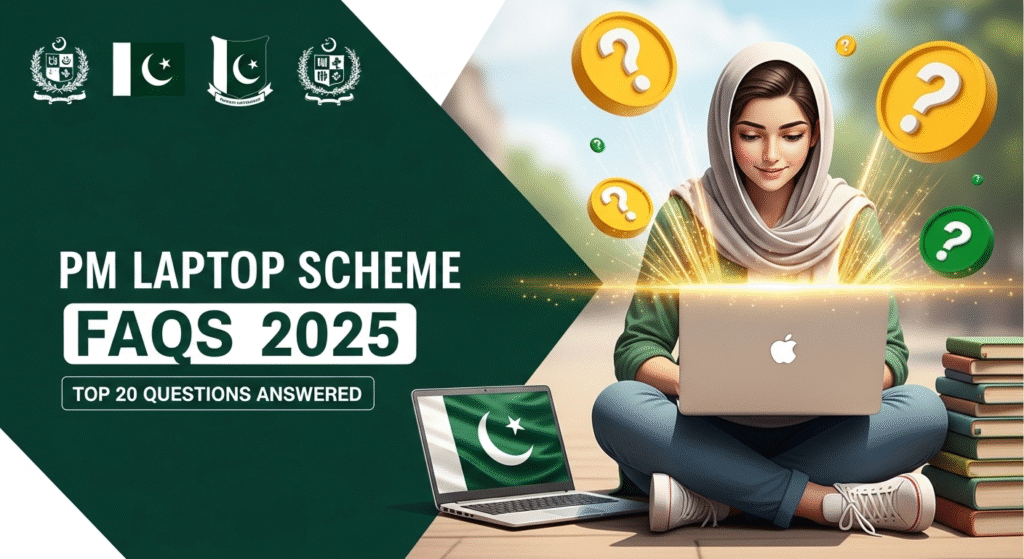The Prime Minister Youth Laptop Scheme 2025 is a landmark initiative by the Government of Pakistan to promote digital learning and empower students enrolled in public universities nationwide. With technology playing a vital role in modern education, this scheme ensures that talented students have the tools they need to succeed academically and professionally.
Many students, however, find the process confusing — from checking eligibility to applying online, verifying details, or collecting their laptops. To make things easier, we’ve created this detailed FAQ guide that answers the 20 most frequently asked questions about the PM Laptop Scheme.
Whether you’re applying for the first time or checking your status in Phase IV, this guide will help you understand everything — from eligibility rules and document requirements to troubleshooting the HEC laptop portal.
Each phase of the scheme opens new doors for students to receive free laptops that support research, online learning, and skill development. But due to changing criteria and university eligibility updates, many applicants face challenges navigating the system.
That’s why this comprehensive FAQ section provides clear, updated, and verified answers — so you can avoid common mistakes and confidently complete your application for the Prime Minister Youth Laptop Scheme 2025.
Prime Minister Youth Laptop Scheme – Top 20 Frequently Asked Questions (FAQs)
1. How can a university student apply for the PM Youth Laptop Scheme?
Students can apply by registering through the official Students’ Service Portal at laptop.pmyp.gov.pk. If you had previously validated your record in Phase-II, you only need to update your profile.
2. I’m in the 7th semester of a BS program and scored 65% in the last semester. Am I eligible?
Eligibility is based on cumulative GPA (CGPA), not semester-wise performance. So your overall CGPA will be considered.

3. My university uses the CGPA system. Do I need to convert it to percentage?
No conversion is required. The scheme accepts the grading system used by your institution, whether it’s CGPA or percentage. For clarification, you can reach out to your university’s focal person.
4. My university asked for department-wise data of eligible students. Can I apply by email?
No, only individual applications submitted through the online portal are accepted. Make sure your details are correctly filled in on the portal to avoid disqualification.
5. My university isn’t listed under eligible institutes. Why is that?
All public sector universities and degree-awarding institutions are included. You can check the official list on the PM Laptop Scheme website under “Eligible Universities/HEIs.”
6. Do orphans studying in public universities get any special preference?
There is no special quota for orphans. However, if they meet the eligibility criteria like other students, they can apply.
7. Who is eligible for the PM Laptop Scheme?
Any student enrolled in a public sector university as of June 30, 2023, and who meets the merit criteria defined by the scheme, is eligible to apply.
Frequently Asked Questions (FAQs) CM Punjab e-Bike Scheme
8. I’m an MBBS student in an affiliated college of a public university. Can I apply?
Unfortunately, students from affiliated colleges are not eligible. Only students from universities or their constituent campuses can apply.
9. I transferred from another institution. Can I use my old CGPA to apply?
No, you must apply through the university where you are currently enrolled. Your current institute’s record will be considered.
10. How can I know if I have been selected for the laptop?
Log in to the Student Service Portal and check your selection status using your CNIC number at laptop.pmyp.gov.pk/.
11. Can someone else collect the laptop on my behalf?
No, only the selected student is allowed to receive the laptop. Personal presence at the distribution venue is mandatory.

12. I enrolled in university in 2017. Am I eligible?
Eligibility depends on the degree program and phase. Older enrollments are generally not eligible, so refer to the detailed criteria listed on the scheme’s website.
13. I’ve been selected. When will I receive my laptop?
Laptops are distributed by the universities according to their schedule. You will receive an official notification about the date and time for collection.
14. I applied in earlier phases but wasn’t selected. Can I apply again?
Yes, if you meet the current eligibility criteria, you are welcome to apply again in the latest phase.
15. I entered incorrect information during registration. What should I do?
Immediately contact your university’s focal person before verification starts so they can correct the mistake in your application.
16. Can I use my father’s CNIC for registration?
No, you must use your own CNIC, mobile number, and email address. Any incorrect details may result in rejection.
17. My portal status says “Asset Issued” but I haven’t received the laptop. What now?
This status means your laptop has been sent to your university. Contact your university’s focal person to collect it.
18. My department is missing from the registration list. What should I do?
Contact your university’s focal person. They will request an update in the system to include your department or program.
19. I accidentally marked “Yes” for receiving a laptop before. Can I change it?
Students who have previously received a laptop are not eligible again. If it was a mistake, contact your focal person quickly to get it corrected.
20. What does “Asset Issued” mean on my student portal status?
It means the laptop has been dispatched to your university and is ready for collection. You need to get in touch with the focal person at your institute to receive it.


1 thought on “Frequently Asked Questions About PM Youth Laptop Scheme in Pakistan”